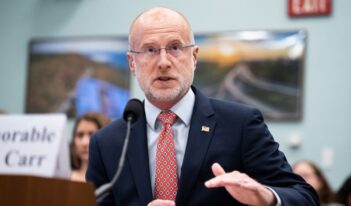
Industry and regulators move forward on next generation wireless broadband.
Just as the current version of wireless broadband technology, known as 4G LTE, becomes widespread in the United States, companies and regulators have already set their sights on the next generation: 5G. This year’s Mobile World Congress, held in February, gave telecommunications companies a chance to showcase the future of high-speed mobile Internet access. Meanwhile, Federal Communications Commission (FCC) Chairman Tom Wheeler has already called 5G a “national priority.”
Before companies commercially launch 5G, international and national regulators hope to develop a common standard for the technology to ensure interoperability among mobile carriers. Though not required, such a standard would allow customers to use their smartphones anywhere in the world and would enable companies to market their devices globally—two important attributes in an increasingly globalized world.
Although 5G will likely not deploy commercially for another five years, mobile companies have already made several ambitious claims about the technology. Download speeds will likely be fast enough to load movies to your smartphone in seconds rather than minutes. 5G also promises much lower latency—the time delay it takes information to travel from point to point—which could further developments in self-driving cars, smart homes, and virtual reality. Such rapid responsiveness could even enable a surgeon in Tokyo to operate remotely on a patient in New York, according to some reports in the telecommunications industry.
Despite all of these claims, the exact specifications of 5G will not be defined until the adoption of a common technical standard—a process still several years away. The International Telecommunications Union (ITU), the United Nations organization responsible for developing and coordinating global technical standards to ensure interoperability among telecommunications technologies, says it will not adopt a standard until 2020.
In developing a common standard for the wireless community, the ITU will review proposals from industry organizations, which it has yet to receive. The 3rd Generation Partnership Project (3GPP), a group of regional telecommunications standard development organizations that created the 4G LTE specifications, plans to submit a 5G proposal to the ITU in 2019. 3GPP will face competition from other groups, including the European Union’s 5G Infrastructure Public Private Partnership (5GPPP). These standards development organizations will work with their partner telecommunications companies and other groups over the next several years to determine which technologies to include in their ITU proposals at the end of the decade.
The international technical standard is not the only regulatory task associated with 5G. National regulators around the globe must also set aside radio airwaves, called spectrum, to accommodate 5G. At last year’s World Radiocommunication Conference, the ITU agreed to adopt a common global radio spectrum, but member countries failed to agree on specific frequencies. The ITU is expected to identify 5G frequencies at the next conference in 2019 after reaching agreement among its members.
In the United States, the FCC is already moving ahead to allocate spectrum for 5G. In October 2015, the FCC adopted a notice of proposed rulemaking to license specific radio frequencies for 5G wireless broadband. The FCC aims to have these frequencies adopted by the ITU in 2019.
FCC Chairman Wheeler believes that the United States should not wait for a common technical standard before allocating spectrum. Instead, he suggests the FCC should make specific radio frequencies available and let private sector companies produce the best technical standard for the allotted frequencies. In contrast to Wheeler’s more targeted approach, FCC Commissioner Ajit Pai expressed concern that certain spectrum may not permit companies and mobile users to take full advantage of 5G. Pai argues that the FCC should allocate as many frequencies for 5G as possible until a global standard crystalizes. Pai’s concern may be somewhat diminished by technological advancements that allow smartphones to operate on multiple frequencies.
The upcoming fights over standards and spectrum mean that the next few years could be somewhat of a free-for-all for 5G wireless technology until the ITU adopts a standard. Sprint offers a cautionary tale from the current generation. As the first 4G adopter in the United States a decade ago, Sprint invested billions of dollars in WiMAX, a competing standard to LTE. The ITU later adopted both WiMAX and LTE as standards in 2012, but LTE won out as the standard used by most mobile companies. In November 2015, Sprint began shutting down its WiMAX network as it shifted to LTE. Sprint picked the wrong standard and is now spending millions of dollars trying to catch up.
Regulators want a more orderly process for 5G, but there are many more players this time around who are not necessarily coordinating with each other. While 3GPP is a front-runner for developing a standard due to its responsibility for LTE, the European Union hopes its 5GPPP will position European telecommunications companies as leaders in the industry.
Despite the ongoing regulatory work, wireless carriers are racing each other to deploy 5G. South Korea wants its wireless carriers to have a 5G network ready by the 2018 Winter Olympic Games. Japan promises the same when it hosts the Olympics in 2020. In the United States, meanwhile, AT&T and Verizon are competing with each other to be the first to deploy 5G. Verizon announced that it aims to have a partial commercial 5G network ready in 2017. AT&T responded by planning to test a 5G network in Austin, Texas by the end of 2016. Not to be outdone, Verizon said recently it was already testing 5G at its headquarters. No matter which carrier launches 5G first, it appears the technology will likely be available to consumers in some limited form well before the ITU’s 2020 timeline.



